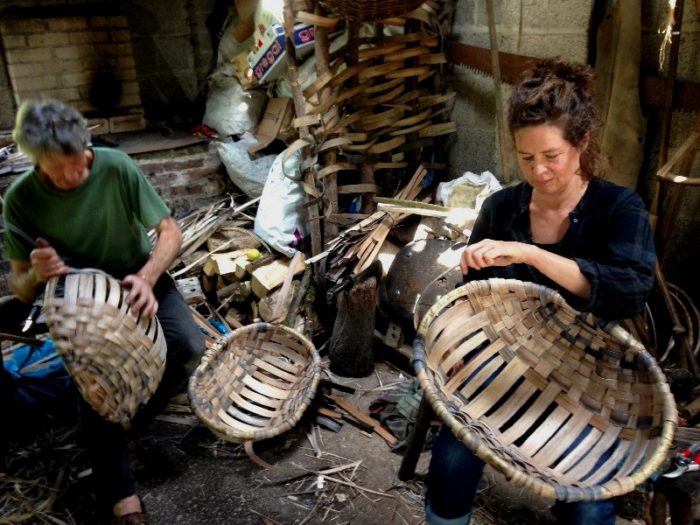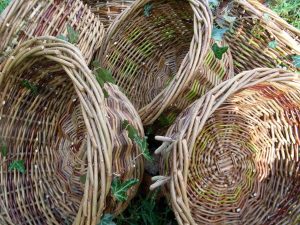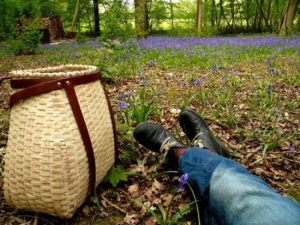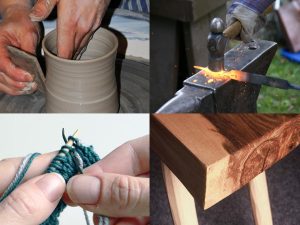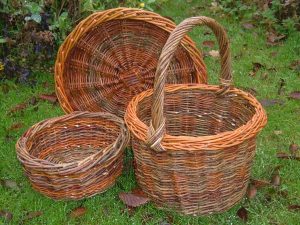We hear from Ruby Taylor of Native Hands about her recent trip to the Lake District, learning how to craft an oak swill with basket maker Owen Jones.
One of the first things you notice about Owen Jones, apart from his friendly, relaxed demeanour, is his hands: huge and work-worn. They’ve definitely seen some years of graft.
I’m at his workshop in Cumbria, to make an oak swill. This is a traditional split wood basket from the region, made by weaving thin strips of riven oak around a steamed hazel rim. The baskets are extremely hard wearing and were used historically in industry, agriculture and domestic settings.
Owen has been making these beautiful baskets for more than 30 years. He was taught in 1988 by a retired swiller from Broughton-in-Furness, called John Barker, who served his time in a 1930’s swillshop. When Owen met him he was one of the last swillers from that generation still making them. Now Owen keeps the lineage alive.
A love of learning, a long standing appreciation of Owen’s swills, and a curiosity about split wood basketry bring me here as a student. It’s a change from my usual role as the Native Hands craft teacher and that’s important for a few reasons. Being nourished by learning something new avoids burn out as a teacher. Learning new skills can make you feel vulnerable; connecting with that vulnerability in myself helps my work. I also appreciate being inspired by other teachers. And I’d really like to have my own oak swill.
Just a glance at the photo at the photo of us in his workshop at the top of this page, and I immediately hear the sound of Owen’s hands (that’s him on the left) as he hits the oak weaver with the heel of his left hand to knock it into place and keep the weave tight; the oak makes a creaking sound as he does this. He handles the materials with an ease and apparent lightness which come from years of intimacy with the process. Oak swills are made in standardised sizes, and here we’re making the size known as Li’le Nick.
Like a lot of basketmaking, it’s robustly physical work and engages all the senses. We start with a recently cut tree: a 20 year-old coppiced sessile oak, splitting it into lengths called billets, using wedges, mallets and froes, taking out the heartwood as we go. We scrape off the outer bark which Owen will sell to an oak bark tannery. The billets are boiled for a day in the wood-fired tank to soften, ready to split down further: to fine ribbons for the taws (weavers) and to slightly thicker strips for the spelks (ribs).
Owen pulls a wet, steaming hot length of oak out of the tank with a crow bar and throws it across the workshop floor to me. With old towels wrapped round my knees for protection, I hold the hot oak between my knees and start riving it with a knife and a knocker (small wooden mallet).
Guiding the split carefully to make a long ribbon of material is absorbing and satisfying; it takes a lot of practice to do well and to avoid wastage, so I’m grateful for previous splitting experience. The material quickly cools as it’s split down, so you have to work swiftly to make the most of the short-lived, increased flexibility from the dampness.
Fingers turn purple from tannin in the oak, and I’m beginning to understand the state of Owen’s hands. The work demands strength and precision; it’s hard on the hands. The long ribbons, taws, are cleaned up with a sharp knife (above) and the spelks (ribs) refined with a draw knife on a swiller’s mare (similar to a shave horse). Knives are super sharp for this, and you quickly find out that Owen makes it look easy.
Sturdy hazel rods are dressed and bent round a former to make the oval ‘bool’ or rim of the swill. After a couple of attempts where the hazel splits badly from knots in the wood, Owen gives me a hand with a fresh piece. He has to wrestle it into place somewhat to stop it twisting on the former, even with his very strong hands.
One of the most interesting things is that all the elements of the basket are made in advance to standardised lengths and shapes. Each of the 15 spelks (ribs), which determine the shape of the swill, has a particular shape and a specific name. This way, swills can be assembled in a straightforward sequence, following a very accurate recipe. As well as ensuring standard sizing, this also historically allowed for a small assembly line in a swillshop, of 4 or 5 men.
But to us newbie swillers it’s a slower task: Owen patiently talks us through each step. Gradually your hands and fingers find how the material needs to be handled to create the shape and the weave of the basket. What looks initially like a simple weave actually requires a very fine-tuned eye… thankfully he’s on hand with one of those, along with a patient and supportive approach.
The beauty of the place and Owen’s hospitality soften the graft. Overnight we leave spelks and taws to soak in the beautiful small stream (above) that runs by the workshop. Robbo the robin visits, Owen reaches for a box of birdseed under his work bench and Robbo eats from Owen’s outstretched palm. We drink fresh apple mint tea from his garden; lunch each day is a generous homemade spread.
With warm and balmy weather, a few of us swim at the end of each day on a quiet stretch of the majestic Coniston Water, finding a large rock to bask on as we take in the beautiful scenery of the place. Later we head off to our camping field on a nearby hill farm.
It’s been three days of quite hard graft to complete our oak swills. Even then Owen harvested the raw materials for us ahead of time and prepped a few things as we went along. Like with most baskets, there’s much more to making a swill than first meets the eye. Historically oak swill apprenticeships lasted 4 years. I’m more than satisfied with my one swill and the three beautiful days spent making it.
The test of a well made swill is to turn it over and stand on it; that’s how strong they are.
We take Owen’s word for it.
You can watch a beautiful 18 minute film of Owen at work (by Jacob Hesmondhalgh) above, read an interview with Owen and also read an article showing him making a swill. Thanks to Alex Turner for generous permission to use his photos.
Shared from an original post on Ruby’s Native Hands blog available here. You can find out more about Ruby, her work and course opportunities in wild basketry, pottery and other crafts via our directory.
 About the author
About the author
Ruby Taylor of Native Hands has been a maker since she was knee-high, and a teacher for over 20 years. She runs popular courses in Wild Basketry and Wild Pottery using foraged materials in the woods. She has experience of a wide range of basketry techniques and also works as part of a team teaching ancient crafts and technologies.

